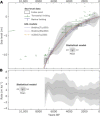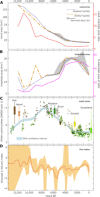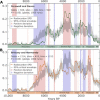Nonlinear landscape and cultural response to sea-level rise
- PMID: 33148641
- PMCID: PMC7673675
- DOI: 10.1126/sciadv.abb6376
Nonlinear landscape and cultural response to sea-level rise
Abstract
Rising sea levels have been associated with human migration and behavioral shifts throughout prehistory, often with an emphasis on landscape submergence and consequent societal collapse. However, the assumption that future sea-level rise will drive similar adaptive responses is overly simplistic. While the change from land to sea represents a dramatic and permanent shift for preexisting human populations, the process of change is driven by a complex set of physical and cultural processes with long transitional phases of landscape and socioeconomic change. Here, we use reconstructions of prehistoric sea-level rise, paleogeographies, terrestrial landscape change, and human population dynamics to show how the gradual inundation of an island archipelago resulted in decidedly nonlinear landscape and cultural responses to rising sea levels. Interpretation of past and future responses to sea-level change requires a better understanding of local physical and societal contexts to assess plausible human response patterns in the future.
Copyright © 2020 The Authors, some rights reserved; exclusive licensee American Association for the Advancement of Science. No claim to original U.S. Government Works. Distributed under a Creative Commons Attribution License 4.0 (CC BY).
Figures




References
-
- M. Oppenheimer, B. C. Glavovic, J. Hinkel, R. van de Wal, A. K. Magnan, A. Abd-Elgawad, R. Cai, M. Cifuentes-Jara, R. M. DeConto, T. Ghosh, J. Hay, F. Isla, B. Marzeion, B. Meyssignac, Z. Sebesvari, in IPCC Special Report on the Ocean and Cryosphere in a Changing Climate, H. -O. Pörtner, D. C. Roberts, V. Masson-Delmotte, P. Zhai, M. Tignor, E. Poloczanska, K. Mintenbeck, A. Alegría, M. Nicolai, A. Okem, J. Petzold, B. Rama, N. M. Weyer, Eds. (In press), pp. 321–447.
-
- Slangen A. B. A., Carson M., Katsman C. A., van de Wal R. S. W., Köhl A., Vermeersen L. L. A., Stammer D., Projecting twenty-first century regional sea-level changes. Clim. Chang. 124, 317–332 (2014).
-
- Nicholls R. J., Cazenave A., Sea-level rise and its impact on coastal zones. Science 328, 1517–1520 (2010). - PubMed
Publication types
LinkOut - more resources
Full Text Sources
Miscellaneous

